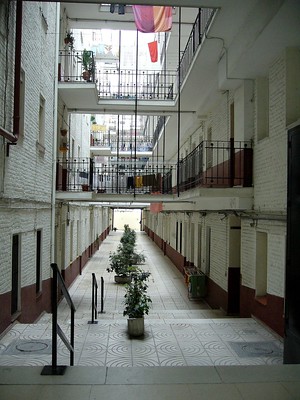If you’re up on architecture, you know that “British architecture” encompasses everything from Stonehenge to Perpendicular Gothic to The Gherkin. But the enduring value of British architecture is at the heart of an issue that has divided Britons on their obligation to care for aging buildings – and what “aging infrastructure” even means.
Bringing this question to the masses is the Centenary Building, first opened on the campus of the University of Salford in 1996. At the time, the Royal Institute of British Architects (RIBA) awarded it the prestigious Stirling Prize, which recognizes excellence in architecture. The prize doesn’t actually go to the building; it goes to “the architect(s) of the building that has made the greatest contribution to the evolution of architecture in the past year.”
In the Centenary Building’s case, that would be Stephen Hodder of Hodder+Partners, who envisioned “a fusion of design and technology.” Originally, the building was supposed to house the University of Salford’s engineering program. Midway through construction, the University shifted that plan and decided to put its art and design programs there instead.
As part of its “futuristic” design, the Centenary Building does not have air conditioning. Instead, it relies on operable windows to move air through the building in the summer months. It’s a tall order for a glass, steel, and concrete structure, given that the glass vastly increases the summertime temperatures in the structure. In the winter, the building relies on heated floors to keep it warm. According to previous inhabitants, that plan also falls short.
Its cavernous interior and metal staircases – which were supposed to resemble streets and alleys – is unbearably noisy, which makes it hopelessly unattractive as a classroom space.
Should we be remodeling aging buildings instead of razing them?
It doesn’t help that after the building was built, the University of Salford centralized its campus, leaving the Centenary Building on the outside looking in. The university rented the building for a while, but tenants didn’t find its heating and cooling plan any more appetizing than did the academic departments for which the building was initially constructed. According to the university, the Centenary Building has been vacant for nearly a decade, and Stirling Prize or not, they’d like to pull the building down and replace it with another development.
That plan has pitted the university against preservationists, who say that 30-year-old construction doesn’t meet the definition of old, and that rehabilitation, rather than the wrecking ball, is what’s needed to return the Centenary Building -and other aging buildings – back to a useful existence.
Their argument is that bad designs, patterns of neglect, periods of vacancy, high heating and cooling costs, and other ills of modern architecture, don’t justify the expense, waste and carbon release involved in razing aging buildings. Instead, building owners should rehabilitate buildings, correct their deficiencies, and spare the planet from the waste involved in demolition. To bolster their case, preservationists are rushing to apply for a historical designation for the 30-year-old glass-and-steel creation to prevent it from being torn down.
This debate will likely have no outcome for years, but it does raise the question about whether or not we should allow a long-term pattern of deliberate neglect to underpin the justification for razing and replacing campus buildings. Instead, should we be evaluating not only the cost of new construction, but also the carbon-tax associated with razing and rebuilding instead of simply rehabilitating aging buildings on campus?
Photo Credit: Jesús Gorriti
















